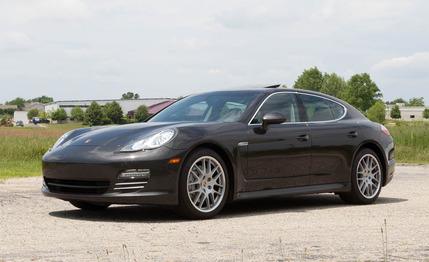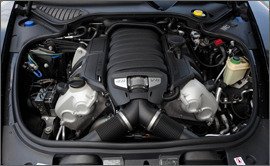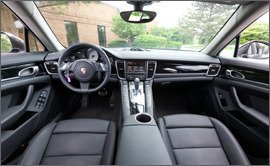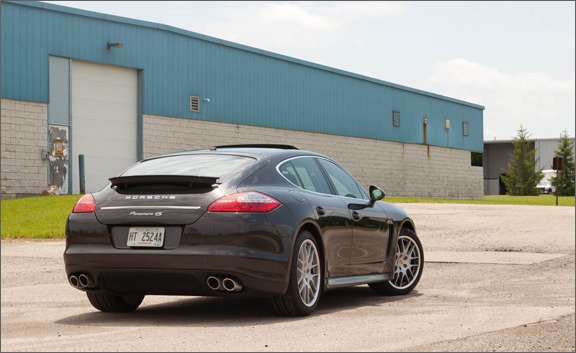
 Short Take Road Test
Short Take Road Test
What Is It?


Well, we’re still not sure. This all-wheel-drive S model is the fourth Panamera variant we’ve tested, and the hatchback cum sedan’s shape still hasn’t completely grown on us. It is agreed, however, that the Panamera is plenty agreeable to drive—and easier to enjoy from inside. Fortunately, that’s where they put the steering wheel and all the important controls. Bless those Germans.
How Does It Drive?
The great thing about the Panamera is that you drive it and not the other way around, as is the case with many big-buck sedans. There are no nanny systems to beep, blink, or otherwise distract, and with the exception of launch control, there are no technoid aids. The launch control is the PDK transmission’s party trick—although other drivers might be too busy trying to figure out what the car is to challenge you to a race—and teams up here with all-wheel drive, a 400-hp V-8, and some fat Michelin Pilot Sport PS2 rubber to deliver a 4.2-second 0-to-60-mph time. That’s 0.5 second quicker than the rear-drive Panamera S. To put things in five-door perspective, the 4S trails our 556-hp Cadillac CTS-V wagon long-termer by just a 10th.


The Panamera’s steering is Porsche light and offers the kind of feedback and accuracy that are a boon on a back road and welcome on a highway cruise, where fewer corrections are better. The interior works well in both situations, too. It’s all-day comfortable, nicely detailed, and functional. Our favorite detail: the ultra-configurable color display that lives in the right-most gauge crescent. We set it up for a weekend trip, displaying speed-limit signs at the top and showing range, distance and time to destination, and audio info on the customizable “vehicle” screen. A nav display, a trip computer, and a phone menu are a flick away using the steering-wheel-mounted thumbwheel.
Over that 500-mile trip, we saw 24 mpg, meaning the car’s 26.4-gallon fuel tank can deliver a range of more than 600 miles. Our overall observed fuel economy was 20 mpg, smack dab in the middle of the EPA’s 16/24 city/highway ratings. Not bad, given the 4200-plus-pound curb weight and our heavy right feet.


How Does It Stack Up?
Despite having several near-competitors in its niche—that was essentially magicked out of thin air—the Panamera 4S might be most easily compared with its sister cars, which have recently expanded to include the S hybrid and Turbo S models. Comparables for the 4S from other makers include the cheaper and softer Audi A7, the harder-edged Mercedes-Benz CLS AMG, and the upcoming BMW 6-series Gran Coupé, which figures to lean more to the grand-touring side of the ledger. This Porsche offers a unique blend of agile, precise handling and comfort.
What’s the Cost?
As with any Porsche, this one’s up to you. The base price of $96,175 isn’t bad as full-bore Euro luxury sedans go (a rear-wheel-drive S can be had for about $5000 less—bargain!). But you’ll surely want to spec the Sport Chrono Package Plus for $1480, because it adds the launch control. Then there was our test car’s extra leather for the seats and dash, which, although playing with funny money, we might as well get, too. We would, however, skip this car’s optional 20-inch wheels and their $3120 upcharge, as well as the colored-in center caps ($185). Our example also had ventilated front seats for $800, a $1990 Bose audio upgrade, extra-cost paint ($790), and the $2350 Premium package, for a (hundred-)grand total of $110,545.
That’s undoubtedly a lot of money, but would you expect hyper-quick weirdness to be affordable?

